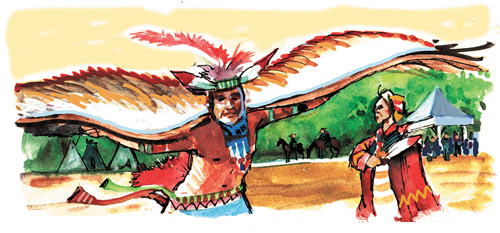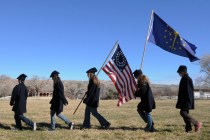American Indian tribes powwow in Pahrump

The 13th annual Pahrump Powwow, one of the Southern Nevada town’s largest cultural events, kicks off Friday.
The three-day gathering draws Native American dancers, drummers, musicians, artists and craftsmen from tribal groups all over the West. This year’s powwow will honor the memory of Joe Morris, a Marine veteran of World War II who was one of the famous Navajo Code Talkers.
To reach Pahrump from Las Vegas, follow Nevada Route 160 west over the mountains for about 65 miles.
Powwow participants and observers gather at Petrack Park off Highway 160 at Basin Avenue for activities held on park grounds and inside the community center. The event starts at 10 a.m. Friday and ends at 3 p.m. on Nov. 20.
This year’s powwow will feature at least 30 juried exhibitors of handmade Native American crafts and works of art as well as several food vendors. Dance and drum contests scheduled during the powwow highlight colorfully costumed performers of different ages in various categories. Unique to Native Americans, powwows provide opportunities to gather together scattered clans for socializing and to foster traditional customs, ceremonies and skills.
Pahrump takes its name from the Western Shoshone-Paiute name for the valley, Pah Rimpi. Translated as "water rock," it describes the place where indigenous people knew abundant water flowed from many artesian springs. The native people used the water to irrigate their little plots of corn, squash and beans successfully for many generations before non-native settlers arrived in the late 1800s.
At first, the new settlers concentrated on just feeding their families, as the native people had done. Soon, the abundance of water encouraged them to grow more. They propagated pastures for livestock, established orchards and planted vegetable gardens. Regional mining camps and emerging communities such as Las Vegas provided ready markets for meat, poultry, eggs, milk, fruit and produce.
Eventually, overuse of the artesian springs caused the water table to drop, and most of them dried up. While the water lasted, Pahrump Valley farmers turned thousands of acres of desert into fields of alfalfa and Egyptian cotton. Very little farming continues today in Pahrump Valley, with the exception of vineyards, whose vines use a fraction of the water sucked up by other crops.
Folks drawn to Pahrump for the powwow might also want to explore the community a little. The largest unincorporated city in Nye County, Pahrump boasts a population of about 36,500, a far cry from the sleepy little crossroads farming community of the past. About one-fourth of its residents are of retirement age, and a good percentage of the people who live in Pahrump work in the Las Vegas area.
Many businesses have sprung up to serve the increasing number of residents: casinos, grocery stores, banks, gasoline stations, fast-food franchises, motels, RV parks, and strip malls filled with offices, stores and movie theaters.
One of the best restaurants in town is at the beautiful Pahrump Valley Winery. The stately property with beautiful grounds is often used for weddings, receptions and parties and offers tours of the facility, wine-tasting area and adjacent gift shop.
Head for the Pahrump Valley Museum to learn more about area history. The museum, at 401 Basin Ave., is open free of charge Tuesdays through Saturdays from 10 a.m. to 4 p.m. Approach the entrance through a cactus garden maintained by the local garden club. Stroll about to view the outdoor statuary, a collection of 10 Italian bronzes depicting children at play, wild animals and other subjects. Interior exhibits include artifacts and information about pioneer life, mining, agriculture and native cultures. A highlight is the fine collection of Abraham Lincoln memorabilia.
Margo Bartlett Pesek’s column appears Sundays.


















